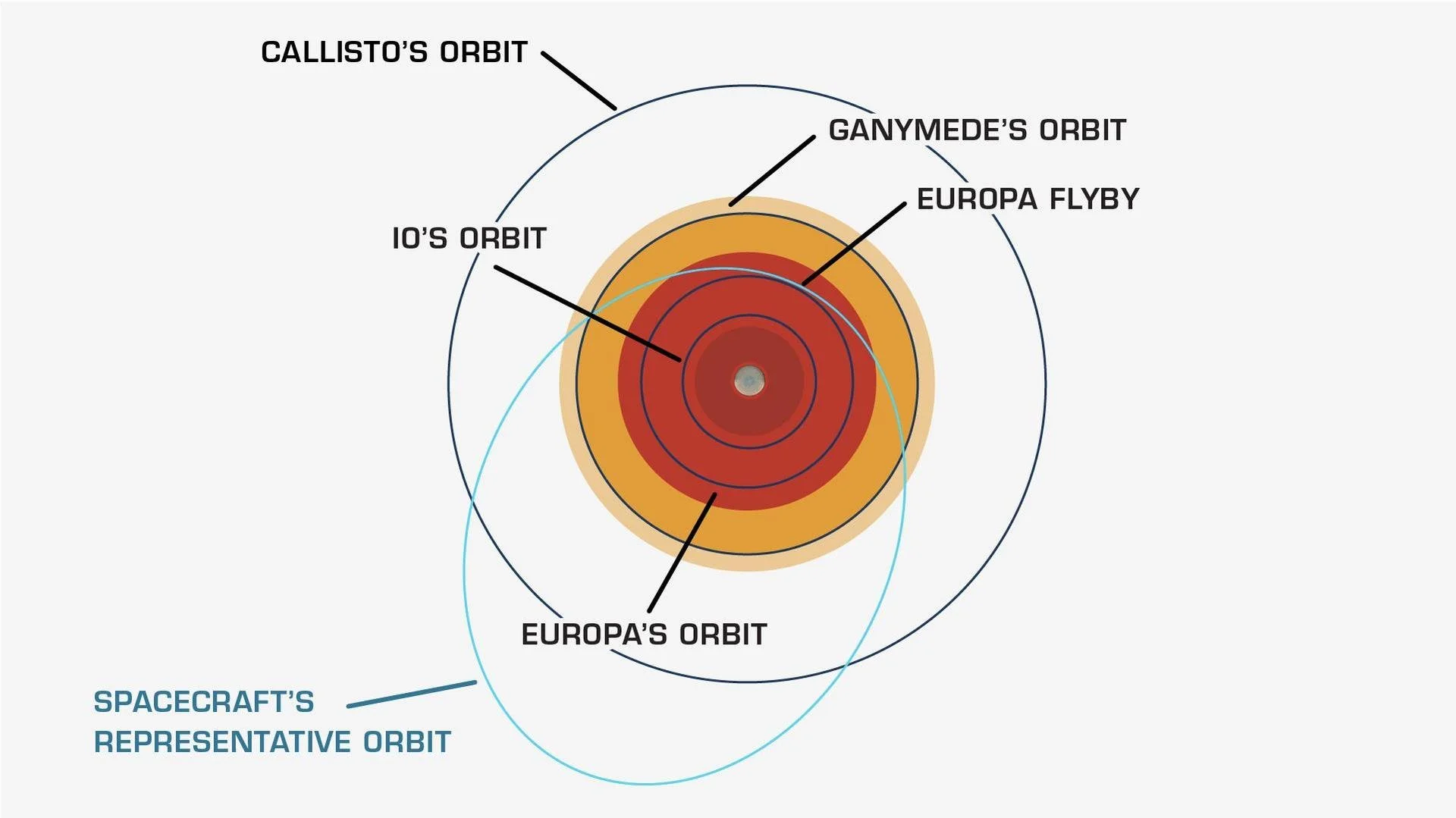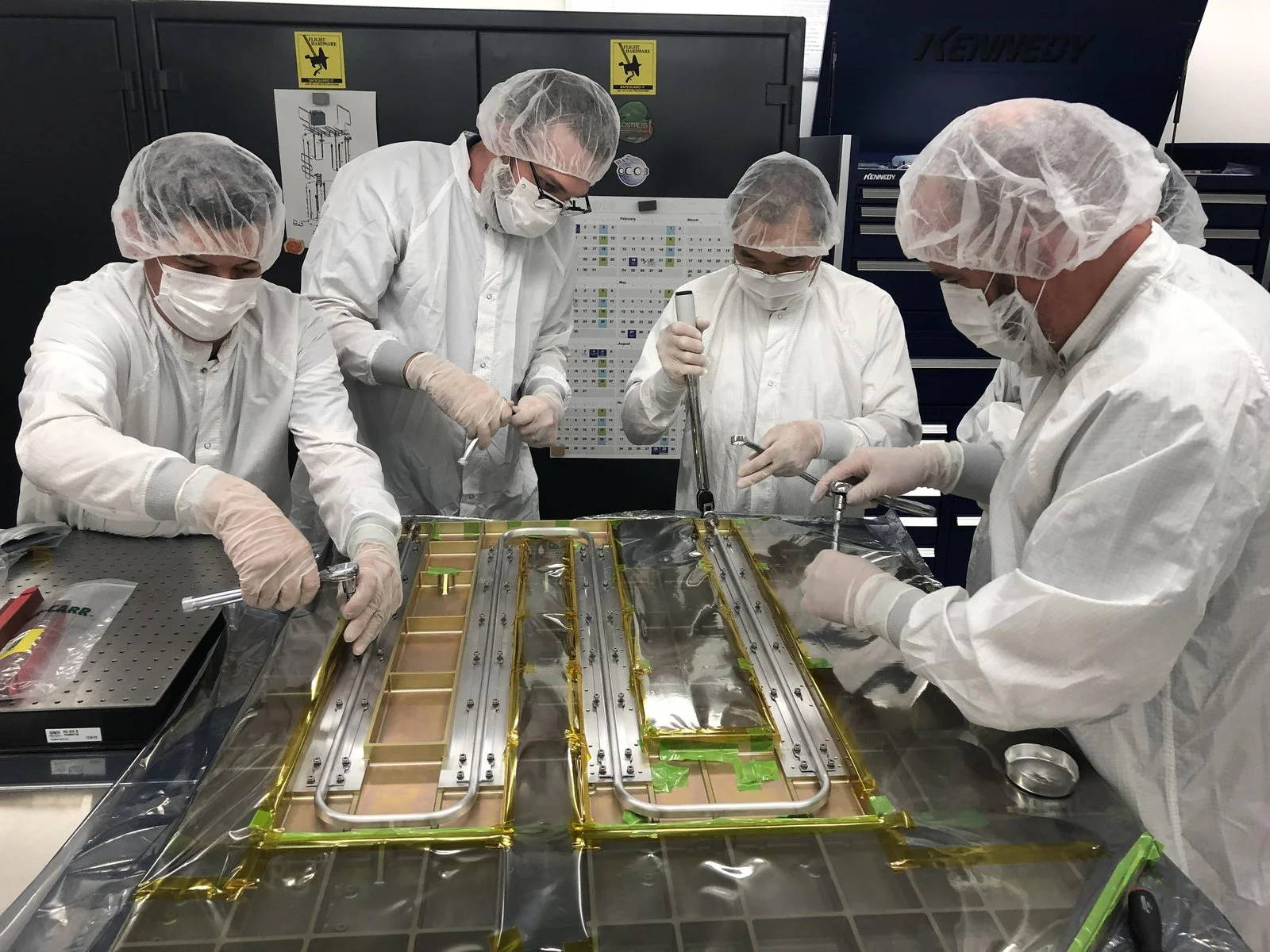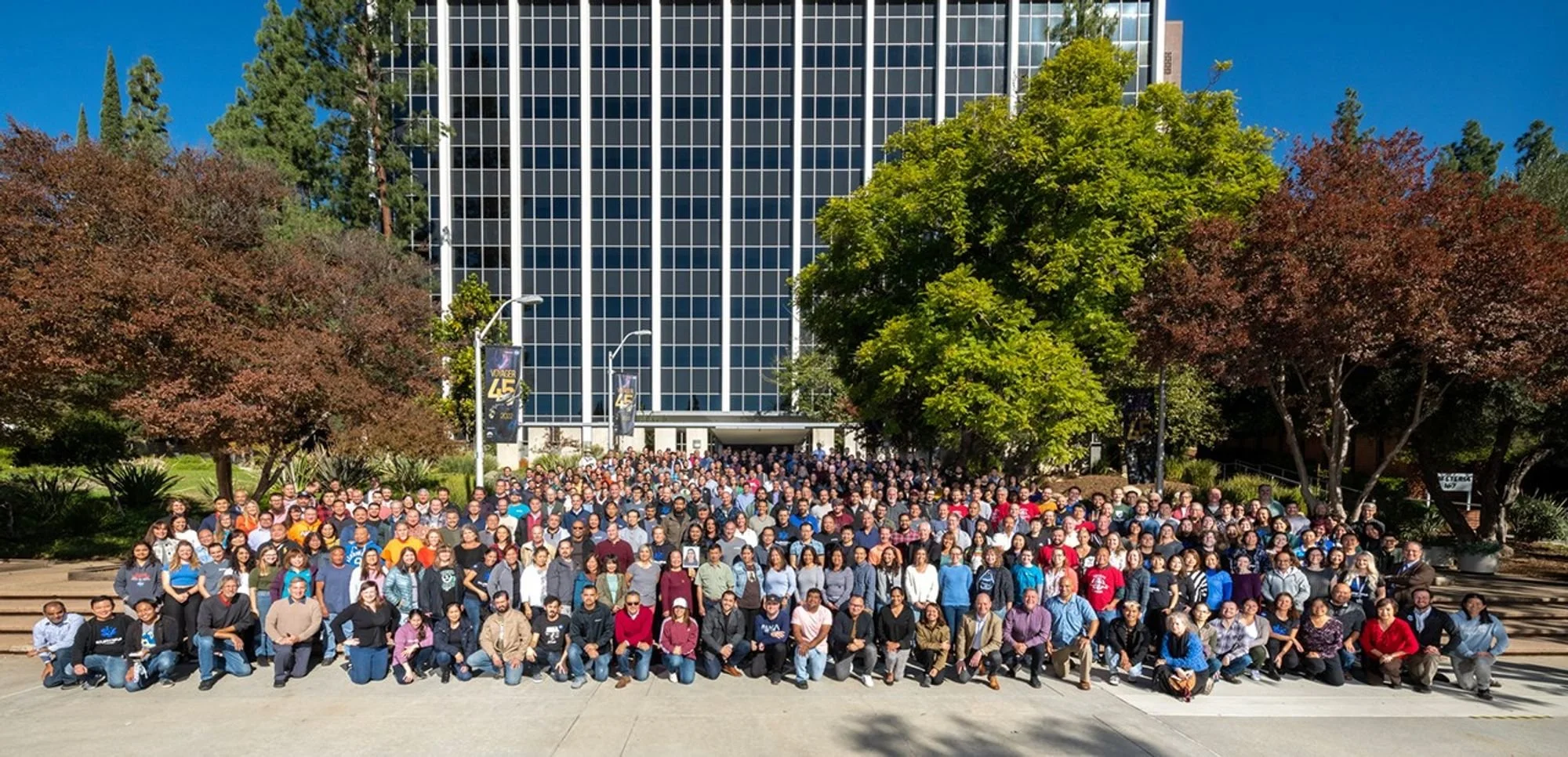Go Big and Go to Jupiter: 10 Engineering Challenges Europa Clipper Had to Overcome
Credit: NASA/JPL-Caltech
By Sabrina Pirzada
When Europa Clipper launched in October 2024, the spacecraft began one of the most ambitious planetary science missions in history. Its destination—Europa, one of Jupiter’s moons—shows evidence of liquid water under its icy shell, which makes scientists wonder if there could be conditions like the deep-ocean environments on Earth that can support life. The mission, run by the Jet Propulsion Laboratory (JPL), which Caltech manages for NASA, will help scientists better understand the potential for habitability beyond our world. But before Clipper could even begin its scientific quest, the engineers and scientists involved in the mission had to face down an array of technical and environmental challenges that pushed the limits of spacecraft design.
In her May 2025 Watson Lecture, Tracy Drain, Europa Clipper chief engineer in operations, shared stories from the mission’s development, launch, and its continuing journey to Jupiter. Here she describes 10 of the most formidable obstacles they navigated along the way:
(1) Designing Enormous Solar Arrays
Europa Clipper shown in an artist’s concept overlaid on a basketball court. Its solar arrays span 100 feet—necessary to power the mission in the dim sunlight of Jupiter’s orbit. Credit: NASA/JPL-Caltech
At an average distance of just over five times Earth’s distance from the Sun, Jupiter receives less than 1/25th as much solar energy per square meter. To compensate, engineers equipped Europa Clipper with the largest solar arrays ever deployed on a planetary mission. “If you want a solar-powered mission that far out, you have to go big or go home,” said Drain, who described the spacecraft as being so wide it “hangs off the edges of a basketball court.”
(2) Flying Through a “Giant Donut of Radiation”
Caption: Europa orbits deep within what Tracy Drain calls a “giant donut of radiation”—a band of high-energy particles trapped by Jupiter’s powerful magnetic field. To limit the damaging effects of this radiation, Europa Clipper will follow an elliptical orbit, performing close flybys of Europa while spending most of its time in safer, lower-radiation regions from which it can safely transmit its science data back to Earth. The relative intensity of Jupiter’s radiation bands is illustrated here, along with the orbits of Jupiter’s three other largest moons: Io, Ganymede, and Callisto. Credit: NASA/JPL-Caltech
“Jupiter has a giant donut of radiation around it, with Jupiter sitting right in the donut hole. Europa orbits within the donut itself,” Drain said. Jupiter’s immense magnetic field traps charged particles—driven by solar wind and volcanic activity on Io—into a torus belt of radiation. Flying through it unprotected would damage critical systems. The solution: a radiation “vault” made of aluminum nearly a centimeter thick to house the spacecraft’s most sensitive electronics, paired with a flyby trajectory designed to spend as little time as possible within the radiation belt.
(3)The “Wedding Seating Chart” of Space Engineering
Caption: Engineers work with Europa Clipper’s star trackers—cameras that help the spacecraft orient itself by recognizing star patterns. To function properly, they must maintain an unobstructed view of space. Along with radar instruments, solar panels, and other components, the star trackers had to be positioned with extreme care. Credit: NASA/JPL-Caltech
During the latter part of the “cruise” phase, when Europa Clipper will be closest to the Sun, thermal management becomes a puzzle. To keep parts of the spacecraft from overheating, engineers plan to point its High Gain Antenna directly at the Sun, effectively shading sensitive components. At the same time, the solar arrays must be tilted slightly off-axis to prevent them from generating excess voltage. But they can’t tilt too far because the REASON (Radar for Europa Assessment and Sounding: Ocean to Near-surface) mounted on the arrays, might drift into the star trackers’ field of view. Designing around these interlocking constraints required extraordinary precision, where every component’s orientation had to be choreographed with care.
“This is one of those things where you're planning your wedding, and you know that person A cannot sit next to person B but really needs to be at the table with person C, and if you don't get this right, everything is going to be a disaster,” Drain said.
(4) Extreme Heat and Intense Cold
Caption: Engineers and technicians bond thermal tubing to Europa Clipper’s radio frequency panel during assembly. The tubing is part of a Heat Redistribution System that pumps coolant throughout the spacecraft to help manage its temperature in the extreme environments of space. Credit: NASA/JPL-Caltech
To survive both scorching temperatures during its gravity-assist flybys near the Sun and frigid conditions near Jupiter, Europa Clipper needed a sophisticated thermal management system. The spacecraft’s Heat Redistribution System (HRS) circulates coolant throughout the structure, repurposing heat emitted from its electronics to warm its fuel tanks. When “life testing” showed two pumps weren’t enough, engineers found a way to install a third. (Late-stage hardware additions to a finalized spacecraft design even in the early stages of the craft’s construction are rare and remarkably difficult.)
(5) A Crucial Pre-Launch Adjustment
Caption: NASA’s Europa Clipper underwent testing to prepare for the electrical and magnetic conditions of space. Engineers had to develop an onboard “canary box” to monitor the transistors across the spacecraft.
Credit: NASA/JPL-Caltech
Just months before launch, the Europa Clipper team made a troubling discovery: The transistors that had been chosen because of their radiation tolerance (more than 1,500 in all were used across the spacecraft) had shown signs of degradation in ground testing under simulated deep-space radiation conditions. The engineers devised an innovative solution with their very own canary in a coal mine. Built in just three months, a small onboard “canary box” contains samples of the vulnerable transistors, deliberately exposed and wired for continuous monitoring. This system will provide some indication of the health of the transistors on the spacecraft in Jupiter’s intense radiation environment, giving mission operators a heads up if there is a potential need to adjust operations.
(6) Surviving a Hurricane
Caption: Hurricane Milton nears NASA’s Kennedy Space Center days before Europa Clipper’s scheduled launch in October 2024. Credit: NASA
With Clipper on the pad at Cape Canaveral and just days from launch, Hurricane Milton arrived. “We thought, ‘This can’t be real,’” Drain said. As the storm approached, almost all the team members at Kennedy Space Center were evacuated, then waited anxiously to learn whether the mission hardware—tucked inside the launch vehicle and sheltered in the hangar—would endure. It did.
(7) Hitching a Ride to Space
Caption: Europa Clipper beginning its journey on its own after successfully separating from its launch vehicle, SpaceX’s Falcon Heavy. Credit: NASA TV/SpaceX
Europa Clipper rode to space aboard the SpaceX Falcon Heavy. With less than three minutes to liftoff, an anomaly alert sounded in the control room. “At two minutes and forty seconds, you’re just watching and hoping,” Drain said. The team stayed calm, the issue was resolved, the countdown continued, and Clipper blasted off into the sky. Onboard cameras captured spacecraft separation. Engineers who had worked on Europa Clipper for years watched, in real time, as it gently detached from its rocket and floated off into space. “It really did feel like separation anxiety,” Drain. “Like seeing your baby walk across the stage.”
(8) Waiting in Silence During a Disaster
Caption: The Flight Projects Center at JPL the night of the Eaton Fire on January 7, 2025. Credit: Friends of NASA
In January 2025, the devastating Eaton Fire forced the evacuation of JPL. Europa Clipper was still in its critical early phase. “It’s like we had our baby spacecraft that just launched a few months ago, and now we had lost our ability to talk to it,” Drain recalled. “And it was the right thing to do. The Lab had to shut down. We were in danger. It just was what it was.”
Although NASA’s Deep Space Network was receiving and recording data from the Clipper spacecraft, the JPL mission team could not access the data or send commands until Lab facilities were back online. Soon after the fire danger had passed, the critical systems were back up and operating, and no data was lost.
(9) A Long Game of “Are We There Yet?”
Europa Clipper spacecraft, depicted in this artist’s concept, will orbit Jupiter and perform close flybys of the planet’s ice-covered moon Europa. It is set to arrive in April 2030. A one-way mission, it will remain in the Jovian system for the rest of its operational life as it searches for signs of habitability beneath Europa’s frozen crust. Credit: NASA/JPL-Caltech
Clipper won’t reach Jupiter until 2030—which means five and a half years will pass between launch and when its main science mission can start. In the meantime, the cruise phase demands as much precision as the science phase, as engineers manage deep-space navigation, software updates, and system checks for a spacecraft that must remain fully operational through the end of the mission in 2034.
(10) Building an Incredibly Complex Spacecraft... from Their Kitchen Tables
Caption: The Europa Clipper team gathered at JPL. Credit: NASA/JPL-Caltech
Much of the mission’s final design phase, including its critical design review and systems integration planning, happened in 2020 and 2021 during the height of the COVID pandemic. That means the work happened entirely remotely. “My cats loved that I was home all the time,” Drain joked.
From their makeshift home offices, JPL and APL (Johns Hopkins Applied Physics Laboratory) engineers finalized the design of one of the most complex spacecraft ever assembled. Thanks to this team, Clipper is now en route to Europa.
As Drain put it:
“The science is cool. The engineering is awesome. But getting to work with these people is really the thing that motivates me and gets me up out of bed every day.”
Europa Clipper is expected to arrive in Jupiter’s orbit in April 2030. Its science phase will include nearly 50 flybys of Europa to gather data on the moon’s potential habitability. The mission is led by the Jet Propulsion Laboratory in partnership with the Johns Hopkins Applied Physics Laboratory, with substantial contributions from across the Caltech campus community.
Stay in the Know
Sign up for the Watson Lecture mailing list to receive invitations to upcoming events. mailchi.mp/caltech/watson-partners











